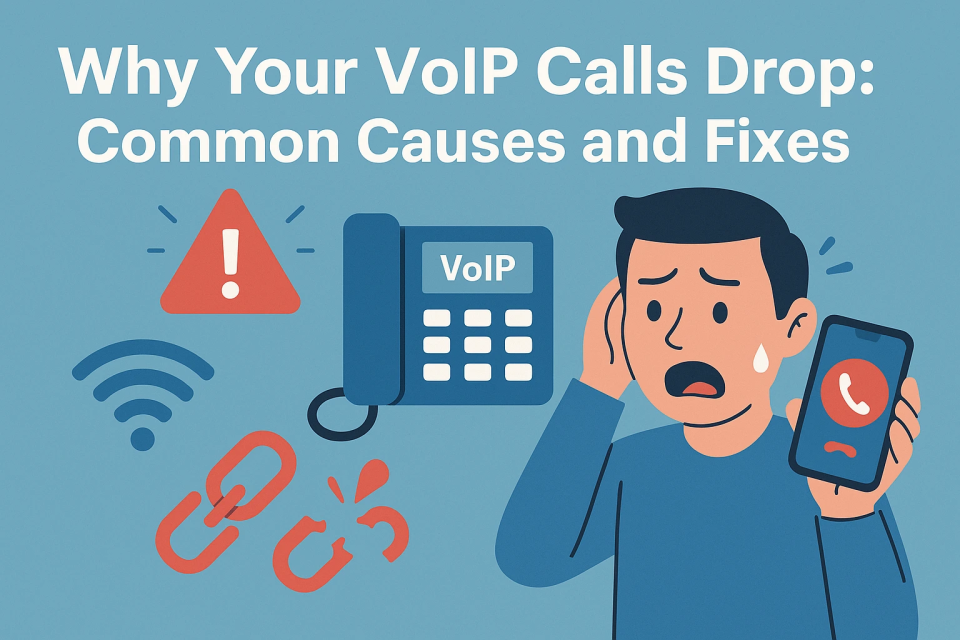Why Your VoIP Calls Drop: Common Causes and Fixes

VoIP (Voice over Internet Protocol) has transformed the way businesses and individuals communicate. It’s cost-effective, scalable, and offers advanced features that traditional phone systems cannot match. Yet, despite its advantages, one issue continues to frustrate users: dropped VoIP calls. Imagine being in the middle of closing a deal with a client, presenting a proposal, or hosting a remote meeting suddenly, the line goes dead. Dropped calls not only disrupt workflow but also damage credibility and reduce productivity. In this blog, we’ll dive deep into the reasons why your VoIP calls drop, explore technical and non-technical causes, and provide actionable steps to fix the problem for good.
Understanding VoIP and Call Reliability
Before addressing the problem, let’s quickly revisit how VoIP works. Unlike traditional phone systems that rely on circuit-switched networks, VoIP uses packet-switched internet protocols. Your voice is converted into digital packets, transmitted over the internet, and reassembled at the recipient’s end.
This process is efficient, but it also makes VoIP vulnerable to interruptions caused by bandwidth issues, latency, jitter, and hardware/software misconfigurations. Because VoIP depends heavily on internet quality, call drops can occur if any component along the chain malfunctions.
Top Reasons Why Your VoIP Calls Drop
Let’s break down the most common causes of dropped VoIP calls:
1. Insufficient Bandwidth
VoIP calls require stable and adequate bandwidth. If your internet connection is slow or congested with other activities (like video streaming or large downloads), it can’t allocate enough resources for a smooth call.
- Symptoms: Choppy audio, delayed speech, or calls ending abruptly.
- Fix: Ensure a minimum of 100 kbps upload and download speed per call. Use Quality of Service (QoS) settings on your router to prioritize VoIP traffic.
2. Network Congestion
Shared networks in offices or homes can cause congestion when too many devices are active simultaneously. VoIP packets might be delayed or dropped, leading to call interruptions.
- Symptoms: Call quality fluctuates based on time of day (e.g., worse during peak usage).
- Fix: Upgrade your internet plan or use dedicated bandwidth for VoIP systems.
3. High Latency
Latency is the time it takes for data packets to travel from source to destination. Anything over 150 milliseconds can cause noticeable delays and increase the likelihood of dropped calls.
- Symptoms: Echo, talking over each other, sudden disconnections.
- Fix: Use wired connections instead of Wi-Fi and choose servers closer to your location.
4. Jitter
When data packets arrive out of order, jitter occurs. This leads to uneven sound quality and may cause calls to drop if the jitter buffer cannot handle the irregularity.
- Symptoms: Words sounding jumbled or cut off.
- Fix: Use routers with jitter buffers and maintain a consistent internet speed.
5. Unstable Wi-Fi Connections
VoIP works best on wired connections. Wi-Fi, while convenient, can be unreliable due to interference, weak signals, or distance from the router.
- Symptoms: Calls drop when moving around the office or home.
- Fix: Use Ethernet connections for critical calls or install Wi-Fi boosters for stability.
6. Firewall and Security Restrictions
Sometimes, firewalls and network security tools block VoIP traffic. This can result in calls dropping when your system fails to establish or maintain a connection.
- Symptoms: Inconsistent connectivity, calls disconnecting after a fixed time.
- Fix: Configure your firewall to allow VoIP protocols like SIP (Session Initiation Protocol).
7. VoIP Server or Provider Issues
Not all VoIP providers are equal. If the provider’s infrastructure is unstable, you may experience frequent disconnections.
- Symptoms: Multiple users in the same organization facing the same issue.
- Fix: Choose a reliable VoIP provider with guaranteed uptime and strong support.
8. Hardware Malfunctions
Old or incompatible VoIP phones, headsets, or routers can cause calls to drop unexpectedly.
- Symptoms: Problems occur only on specific devices.
- Fix: Upgrade to VoIP-compatible hardware and keep firmware updated.
9. Session Timeout Settings
Some systems have predefined session timers. If these settings are misconfigured, calls may automatically disconnect after a certain duration.
- Symptoms: Calls drop at predictable intervals (e.g., every 30 minutes).
- Fix: Adjust session expiration settings in your VoIP system configuration.
10. ISP Restrictions
Some Internet Service Providers (ISPs) throttle or block VoIP traffic. This can cause poor call quality or unexpected drops.
- Symptoms: Issues worsen during peak hours, affecting only VoIP calls.
- Fix: Check your ISP’s VoIP policies or switch to a business-grade ISP plan.
How to Troubleshoot Dropped VoIP Calls
Now that we know the causes, let’s explore troubleshooting strategies:
Step 1: Test Your Internet Connection
Run a VoIP speed test to check bandwidth, latency, and jitter. This provides a baseline for diagnosing issues.
Step 2: Prioritize VoIP Traffic
Configure your router’s QoS settings to prioritize VoIP over other internet activities.
Step 3: Switch to Wired Connections
Whenever possible, connect devices directly to the router with Ethernet cables.
Step 4: Check Hardware and Firmware
Replace outdated routers, VoIP phones, and headsets. Make sure the firmware on every device is up to date.
Step 5: Work With Your VoIP Provider
If internal troubleshooting doesn’t help, consult your VoIP provider for advanced diagnostics and potential fixes.
Best Practices to Prevent Future Call Drops
- Invest in Business-Grade Internet
Residential internet may not guarantee the stability required for VoIP. Business internet plans usually offer higher reliability and service-level agreements (SLAs). - Regular Network Monitoring
Use monitoring tools to proactively detect bandwidth spikes, jitter, or latency issues. - Redundant Internet Connections
For critical business operations, set up a backup internet connection to ensure continuity during outages. - Employee Training
Train staff on VoIP best practices—like staying close to Wi-Fi access points or avoiding heavy downloads during calls. - Work With a Managed Service Provider (MSP)
MSPs like Technijian can handle network optimization, monitoring, and VoIP management, saving your team time and reducing disruptions.
Real-World Impact of Dropped Calls
The consequences of dropped VoIP calls extend beyond frustration:
- Business Reputation: Clients may perceive your company as unprofessional.
- Lost Productivity: Teams waste time reconnecting and repeating information.
- Missed Opportunities: Dropped sales or support calls can result in revenue loss.
Future of VoIP Reliability
The good news? VoIP reliability is improving. With the rollout of 5G networks, better compression technologies, and advanced AI-based monitoring, dropped calls will become less common. Businesses that invest in robust VoIP infrastructure now will stay ahead in customer satisfaction and team productivity.
Conclusion
VoIP is a powerful communication tool, but dropped calls can hinder its potential. The key to preventing this lies in understanding the root causes whether it’s bandwidth limitations, network congestion, or misconfigured hardware and implementing proactive solutions.




No comment